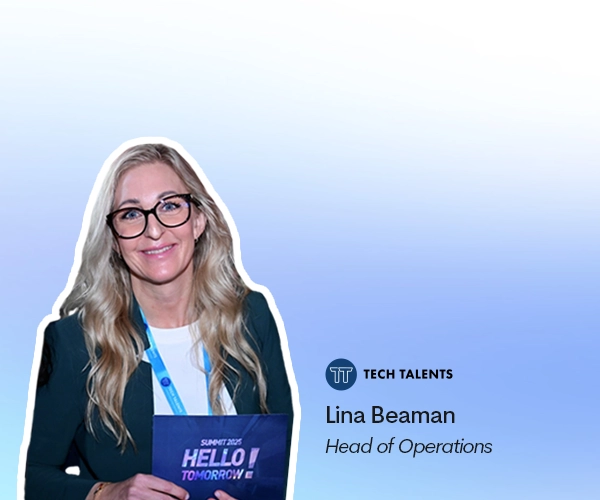Being an attractive employer in today's competitive job market is key to attracting and retaining top candidates. Employer branding gives you the opportunity to influence how you are perceived by your current employees and the top candidates you want to reach. By following a data-driven employer branding strategy, you can ensure that your company is top-of-mind for the candidates you are looking to attract and retain. Here's our guide to data-driven employer branding, containing five simple steps to help you get started.
Step 1: What is your current situation? Research, identify needs and set measurable goals.
The first step in creating a strong foundation for your data-driven Employer Branding strategy is to conduct a thorough analysis of your current state. This involves evaluating your business objectives, identifying your challenges, defining your target audience, and researching your competitors' approaches.
To do:
- Define growth plans and business goals: Find out what your main business goals are for the coming years. For example, do you want to expand into new markets, increase turnover or focus on driving innovation?
- Identify your challenges: What are your current difficulties in attracting, hiring and retaining talent? For example, you have a high cost per recruitment, a low number of relevant applications or long recruitment processes.
- Define clear objectives: What do you want to achieve by working with data-driven employer branding? Do you want to improve, strengthen or change your Employer Brand?
- Collect data: For example, conduct in-depth interviews with employees – if possible, with employees working in the desired target group. Send out an employee survey to effectively collect a larger amount of data.
- Conduct a competitor analysis: find out what your main competitors are offering and how you can position yourself to ensure top candidates are attracted to your offer.
- Research your target audience: Find out where they are, both online and offline, to identify the best way to reach and communicate with your target audience.
- Identify KPIs: Linked to your objectives, are there any KPIs that would be useful to measure during the project? For example, average cost per recruitment, average number of applications per recruitment or average time-to-fill.
Questions to answer:
- What are our main challenges in attracting, hiring and retaining candidates?
- What are the consequences of not closing a hiring process?
- How are we currently working to attract, hire and retain talent?
- What do we want to achieve by working with data-driven Employer Branding?
- What makes us a unique and attractive employer?
- Who are our main competitors recruiting in the same target group?
- What do our competitors offer?
- Who do we want to reach with our employer brand?
- Where is our candidate target group and how can we reach them?
- Which social media do they use most?
- Are there other channels we can use to communicate? What appeals to our target audience?
- Is there anything in particular they look for in an employer?
Step 2: Create your Employee Value Proposition
Based on the insights and data from step 1, it is now time to start building your unique offer to your candidate target group. This will be your Employee Value Proposition, or EVP for short - the unique value proposition you offer your current employees and potential candidates in the market. Your EVP can be seen as the core of your employer branding work. By clearly defining your value proposition, you can more easily create an employer branding strategy that truly represents you as an employer and brings you closer to the goals you defined in step 1.
"Having a finalised EVP is not a requirement to start your Employer Branding work. By getting started and testing what works on your target group, you can build your EVP based on the insights from the external communication." - Elin Blomgren, Specialist in Employer Branding and job advertising at We Select.
To do:
- Define your EVP: Based on the information you gathered in step 1, you can now develop a clear and attractive EVP that tells candidates what you offer as an employer. An EVP often consists of 5 key elements that define your offer: compensation, benefits, development opportunities, work environment and culture. It may also include other unique factors that distinguish you as an employer.
- Communication material: Package your EVP in the form of different messages you want to reach out with internally and externally. Based on these messages, you can then develop marketing materials that can be used when you activate your employer brand in step 4.
- Create a careers page: If you don't already have a central place where potential candidates can access information about you as a workplace and apply for your vacancies, this is the perfect time to create one. For example, on your careers page, you can highlight parts of your EVP and let employees tell you what it's like to work for you. Above all, make it easy to find and apply for your vacancies or submit a spontaneous application.
- Make sure you are visible where your target audience is: In step 1 you identified where your target audience is - online and offline - now you can make sure you are there too. For example, by creating social media accounts on Facebook, Instagram & LinkedIn or registering for relevant fairs and events.
Questions to answer:
- What factors does our target audience consider important when choosing an employer?
- What unique factors can we offer to attract and recruit top talent?
- Which messages do we want to test first?
- How can we effectively and clearly communicate our EVP?
- Which of the channels we identified in step 1 can we use to reach our target audience with our EVP?
- Are we missing any communication channels we need to be on?
- How can we ensure that our EVP is linked to our business objectives?
Step 3: Evaluate and ask for feedback
The third step in a data-driven Employer Branding strategy is to evaluate your offer and ask for feedback from employees, candidates and other decision-makers. This is to get a good insight into how well your EVP and Employer Brand reflect your workplace. In this step, it is important to define the KPIs you want to use to measure your Employer Branding work by looking back at the goals you developed in step 1.
To do:
- Set up metrics and tracking: Make sure you can follow up on the KPIs and targets you want to measure in order to evaluate the results of your employer branding initiative.
- Collect feedback: Conduct new employee interviews and send out surveys that focus on evaluating your EVP and the messages you developed in step 2. This way, you can ensure that what you are communicating is well established in the organization.
- Analyze and apply: Based on the insights you gain, you can identify trends and patterns that may indicate opportunities for improvement. This is a great opportunity to refine your offer and ensure it is accurate and attractive.
Questions to answer:
- What should we measure when it comes to goal fulfilment?
- How can we collect and analyze the data we will obtain during the course of our advertising?
- Do we have what we need to monitor the KPIs we want to report on?
- Is our strategy in line with the objectives we want to achieve?
- Are our messages clearly anchored in our EVP?
- Do we see any trends or patterns in the feedback we receive?
- How can we use the feedback we receive to improve our Employer Branding strategy?
Step 4: Time to reach your target audience
Now it's time to start taking your place in the candidate market - in step 4, all focus is on launching and activating your EVP. You do this by, for example, launching social media campaigns and other activities that highlight your candidate offer to your target group. With the increasing competition for top candidates, this step has become increasingly crucial for successful employer branding. This is to create a presence even with top candidates who are not actively looking for a job.
"We often see that it is at this stage, when the Employer Branding strategy has to move from plan to execution, that many companies slow down. This is often due to an uncertainty around questions like: will we reach the candidates we want with our ads? Have we chosen the right channels? To ensure that their external employer branding efforts reach the right target group, many companies enlist our help in this step. Which also frees up time for them to strengthen their internal Employer Brand." - Amy Dyvelcrona, Employer Branding and Job Advertising Specialist at We Select.
To do:
- Targeted advertising: Create targeted campaigns that allow you to reach the right audience with your chosen messages. Use the different channels you have chosen – for example social media, job sites and fairs - to spread your message.
- Create attractive advertising material: To stand out and create recognition, it is important to focus on engaging and attractive advertising material. Video is an excellent format to quickly capture the interest of the recipient and inform them about your workplace. Focus on really differentiating the messages you are advertising to easily identify what attracted your target audience the most.
- Leverage your employees: By also working with Employee branding, you can use your employees to spread your message in their own networks. Your employees are your biggest ambassadors, you can also highlight them in your Employer Branding material to create an authentic image of you as an employer.
Questions to answer:
- Which channels should we create campaigns on to reach our target audience?
- How can we differentiate the messages we want to get across?
- Which target group(s) should we advertise towards?
- How can we also activate our internal Employer Brand?
- How can we activate our employees to create brand ambassadors that reinforce the message we want to convey?
Step 5: What insights have we gained and what are the next steps?
We are live! After launching your EVP and distributing your developed candidate offer to potential top candidates within your chosen target group, it's time to start collecting insights. Based on reports and the data obtained from the advertising, you can evaluate the results you have achieved in relation to the key figures and goals you have defined. This then becomes the basis that informs you what changes you need to make in the next iteration.
To do:
- Create reports: Set up reports that regularly give you insights linked to the KPIs you want to measure.
- Analyze the outcome: Compile the data you received and look back at the KPIs you chose. Can you see changes in for example average cost per recruitment, average number of applications per recruitment or average time-to-fill.
- Iterate, iterate, iterate: The most important step in a data-driven employer branding strategy is to start again. We recommend working in cycles of 3 months to gather enough data to draw informed conclusions. By learning from insights and data, you can constantly work to improve and change your strategy, bringing you closer to your long-term goals.
Questions to answer:
- What conclusions can we draw from the results of our Employer Branding work in relation to the objectives and KPIs we defined at the beginning of the process?
- Do we see any trends or patterns in the results of our campaigns and initiatives that we can use to make changes and improvements?
- How can we continue to follow the 5 steps of the Employer Branding process on an ongoing basis?
Data-driven employer branding strategy - the basis for proactive recruitment efforts
Working with a data-driven Employer Branding strategy is therefore crucial to effectively attract, hire and retain top talent in the candidate market. By following these 5 steps - defining your goals and challenges, developing an attractive candidate offer, anchoring your strategy internally, reaching out to the right target group on the right channel and collecting insights - you have everything you need to create a well-thought-out Employer Branding strategy.
Data-driven Employer Branding is an ongoing and iterative process that requires analysis and improvement. By evaluating what attracts your target audience and optimising your campaigns on an ongoing basis, you create a proactive recruitment strategy based on real data and insights. Are you ready to get started with employer branding? Book a free consultation with one of our Employer Branding specialists today!





